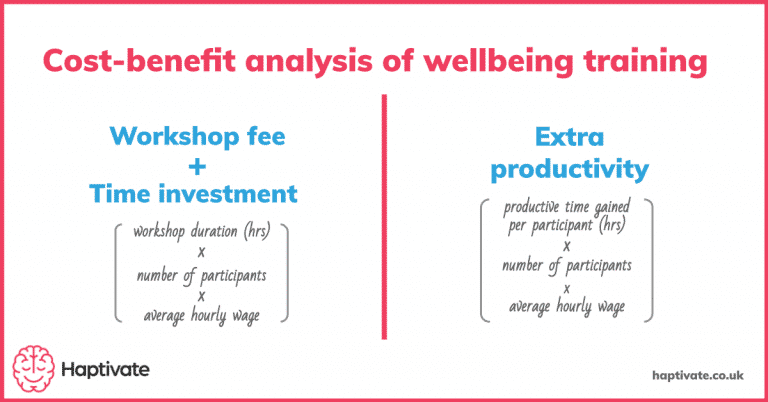How to make a compelling business case for wellbeing at work
Build an ROI model to secure your budget with these 4 simple numbers

It’s a moment many of us dread…
Your team is in serious need of a wellbeing boost and the time has come for you to ask that the purse strings be loosened.
Your team could be on the brink of spontaneous human combustion but someone will inevitably pipe up with something like – “We know Bob’s been awake for three days to finish his latest project…and yes, we’ve also noticed he’s started talking in a made-up language…but I’m struggling to see the business case for a wellbeing workshop.”
Or worse, “Sorry, there’s a ban on all non-essential expenditure. You’re just going to have to learn to communicate with Bob in his new language”
And when you’re already up to your eyeballs in tasks, you don’t have the time or energy to fiddle around in a spreadsheet putting a price on retaining people’s sanity.
Fortunately, it couldn’t be simpler to create a compelling business case for wellbeing activities at work. You don’t need to dig out complex KPIs, use clever formulas or consider multiple scenarios. With just 4 simple numbers, you could create a business case even Ebenezer Scrooge would open up his cheque book for.
Sounds great right? But how do you do it?
OK – Let’s find out!
Making a Business Case for Wellbeing at Work
Small changes make a big difference
If there’s one thing that gets overlooked when people make a business case for wellbeing at work initiatives, it’s this:
Tiny incremental improvements in wellbeing at work during the average working day compound into enormous gains in additional productivity over time.
James Pacey, Co-founder, Haptivate Tweet
Just a few minutes of additional productivity each day per employee adds up to significant savings over time.
But if you asked your budget holder what it would mean for the business if employees enjoyed an extra 5 stress-free minutes to be productive each day, what do you think they would say?
It’s a question they’ve probably never considered before. But all you’ll need to do to get the budget is show them the numbers.
Let’s take a look at an example…
Putting a price on wellbeing – the maths of wellbeing at work ROI
Let’s say your team members make the UK average annual salary of £30,000.
Assuming they work 240 days per year and 8 hours per day, 5 minutes of an employee’s time costs your organisation £1.30. If you’re able to shift 5 minutes of someone’s time from struggling with wellbeing to doing something productive, that’s the cost-saving you make.
That recaptured productivity for one employee is worth:
- £9.10 over a week
- £39.00 over a month
- £468.00 over a year
Now imagine you’re running a wellbeing workshop for ten people – you can add a zero to all of those figures:
- £91.00 over a week
- £390.00 over a month
- £4,680.00 over a year
Compare these numbers to what it might cost you to arrange a wellbeing workshop and it’s not hard to see the significant ROI to be gained.
The four numbers you need to build your business case for wellbeing at work training
Now you understand the underlying rationale, let’s prepare those four simple numbers and get ready for some serious analysis.
To create your business case, you need to know:
- The duration of the workshop
- The fee for the workshop
- The number of participants
- A rough average salary estimate for the participants
Depending on your business, that might look like this:
- The duration of the workshop: 2 hours
- The fee for the workshop: £695
- The number of participants: 30
- A rough average salary estimate for the participants: £30,000
Get free access to wellbeing resources, news and research
Get access to the exclusive Haptivate Wellbeing Resource Hub and stay up to date with all the latest wellbeing at work research, tools and tips by joining our monthly newsletter. We promise not to share your data or spam you with irrelevant information 🙂
Now we’ve got those numbers, let’s get into the clever bit. In the next three steps, we’ll use these figures to calculate an ROI analysis for a wellbeing workshop.
1) How to calculate the true cost of a wellbeing workshop
I find it’s usually best to get the painful stuff out of the way first. So let’s start by considering costs.
We’ll score extra brownie points with the budget-holder by including the workshop fee, and the value of the time the participants give up to take part in the workshop.
To calculate this figure, we’ll use our annual salary estimate to calculate this:
£30,000 ÷ 240 days ÷ 8 hours = an hourly wage cost of £15.63
£15.63 hourly wage cost x 2 hour workshop duration x 30 participants = time cost of £937.50
£937.50 time cost + £695 workshop fee = Total investment of £1,632.50
But what about opportunity cost?
In a profitable business, the productive output of an employee is of course worth more than their wage cost. Therefore, doesn’t this analysis underestimate the opportunity cost of the time spent in the workshop? The answer is yes!
But don’t worry – as we move onto the benefits side of our analysis, we’ll also be underestimating the value of the productive time that’s saved by the same amount. As the underlying basis of our analysis is time, the relationship between the figures is exactly the same whether you’re valuing it using the wage cost or opportunity cost.
And it’s a lot more convenient to just plug in a wage figure rather than trying to quantify opportunity costs.
2) How to find the break even point for your investment in team wellbeing
The big question now is how much productive time does our investment need to save us for it to make economic sense? Let’s run the numbers:
Earlier we calculated our hourly wage cost per employee as £15.63. Now we need to find the wage cost per minute:
£15.63 ÷ 60 = a £0.26 wage cost per minute per employee.
So what’s a minute of productivity worth across a full group of participants:
£0.26 wage cost per minute x 30 participants = a £7.80 wage cost per minute for the full group of participants
If we divide our total investment (above) by this figure, we’ll find out how many minutes of productivity we need to save to recoup the time and money we invest in the training.
Total investment of £1,632.50 ÷ £7.80 wage cost per minute for the group of participants = 209 minutes of productivity that needs to be saved to break even.
That’s 209 minutes over an entire year. .
Things just got really interesting for your budget holder…
But we’re not done yet, what do those 209 minutes mean when we look at people’s daily or weekly routines?
If we divide 209 minutes by the 240 work days across a typical year, the figure you arrive at is just 53 seconds.
That means if participants take enough away from the techniques, tools and tips covered in the workshop to reallocate 53 seconds of their work day from struggling to productivity, you’re in the money.
In other words:
You only need to positively impact 4 and a half minutes of employee time across an entire work week to break even on the required investment for a two hour wellbeing workshop.
James Pacey, Co-founder, Haptivate Tweet
Imagine what it might mean for your organisation if the workshop participants are really paying attention and make some significant changes to their working habits and routines. That’s why at Haptivate, we make sure our workshops are extremely interactive and participants leave with a personal action plan to put their new wellbeing knowledge and skills into immediate practice.

3) How to calculate different investment horizons or payback periods
The above ROI analysis assumes you and your budget holder are happy to wait a full 12 months to realise the benefits of your investment in workplace wellbeing training. But let’s say you’re not. How do the numbers change if you’re a little less patient and want more immediate results?
You just need to divide your 209 minutes of time savings by the number of work days in the required payback period. That’s 120 days for 6 months, 60 days for 3 months and so on…
- For a 6 month investment horizon – you need to save less than 2 minutes per day per employee, or a little under 9 minutes each week.
- For a 3 month investment horizon – you need to save about 3 and a half minutes per day or under 18 minutes per week.
As you can see, the productivity needle only needs to move a tiny bit to prove you’ve made an incredibly shrewd business move.
4) How does the salary of the participants affect the ROI analysis?
When arranging wellbeing training, it’s natural to worry about taking your staff away from their usual work responsibilities for too long. This worry tends to get bigger when more senior and more highly-paid staff are involved.
But you might be surprised to learn that the ROI figures actually get even more enticing as the average salary of the participants increases. This is because while the time cost of the training increases, the value of the time that is saved on the benefits side also increases by the same amount.
In other words, increasing the salary of the participants has no effect on the impact that’s needed to justify the time investment.
However, something very important does change when you increase the salary of the participants. It now takes even less time for you to recoup the cost of the workshop fee because the productive minutes your participants save become more valuable as their salary increases.
The unexpected implication of this that investing in wellbeing skills training becomes more important and yields a greater business impact as you climb the organisational hierarchy.
How much time can a wellbeing workshop really save you?
When people consider the resource cost of wellbeing issues at work, they usually jump straight to absenteeism stats.
In the UK employees miss an average of 4.4 days per year 1 with over half of this being due to stress and mental illness. 2 But believe it or not, it’s the impact that poor wellbeing has on your employees while they’re in work that can be devastating for productivity.
Studies estimate that the productivity cost of latent and unaddressed wellbeing issues in the workplace is 5 times greater than the cost of absenteeism. 3 And it’s not hard to see why. Just think about how much time in the average work week might get taken up by the following wellbeing-related issues:
- Stress and anxiety
- Depression
- Burnout
- Low motivation
- Poor concentration
- Boredom
- Procrastination
- Rumination due to low confidence and self-esteem
- Interpersonal conflict
- Problems outside of work
Need a Hand?
If you’re searching for a partner to help improve wellbeing and happiness in your workplace, get in touch with a friendly member of our team. We’re here to help you reach your goals.
The mind blowing part: how incremental improvements in wellbeing benefit a working lifetime
Now we’ve demonstrated that it takes only extremely marginal improvements in wellbeing at work for you to be quids in with your investments in this area, let’s consider what these improvements might mean for individual employees.
Let’s revisit our original example of giving employees an extra 5 productive minutes in each working day. Remember, these are minutes an employee is free from stress, anxiety, boredom or any other wellbeing difficulty.
Since the average individual spends around 80,000 hours of their life at work, we can easily calculate the potential lifetime benefit of this small change.
Over a working lifetime, just 5 minutes per day equates to an incredible 883 hours that a person can spend being productive rather than unhappy.
This is an enormous win, not only for the individual but also for their family, friends and wider society. The potential ripple effects of comparatively small investments in wellbeing skills training are truly mind-boggling.
And that’s not all…
If you’d like even more data to support your business case for wellbeing at work, check out our article on the benefits of wellbeing at work for all the data points and research you can shake a stick at.
Now have all the tricks you need up your sleeve to get that purchase order in your hand. So it’s time to take a well-deserved break to level-up both your wellbeing and your productivity.
If you’re on the hunt for the right way to give your team a wellbeing boost, check out our range of fun, science-based and interactive wellbeing workshops.
And if you find you’re still in need of backup in your battle for budget sign off, get in touch with our friendly team and we’ll do our best to get you what you need!
Get free access to wellbeing resources, news and research
Get access to the exclusive Haptivate Wellbeing Resource Hub and stay up to date with all the latest wellbeing at work research, tools and tips by joining our monthly newsletter. We promise not to share your data or spam you with irrelevant information 🙂

James Pacey
Co-founder & Commercial Director, Haptivate
Get in touch
Other articles that may interest you…
Important Dates For Your 2025 Wellbeing Calendar (+ FREE Download)
Blue Monday 2025 Survival Guide ft. 10 Science-backed Tips
Important Dates For Your 2024 Wellbeing Calendar
Work from Home Wellbeing Ideas: Nurturing Balance and Wellness in a Remote Environment
- Sickness absence in the UK labour market - Office for National Statistics [Internet]. [cited 2020 Nov 3]. Available from: https://www.ons.gov.uk/employmentandlabourmarket/peopleinwork/labourproductivity/articles/sicknessabsenceinthelabourmarket/2018
- Wilson J. Work-related stress and mental illness now accounts for over half of work absences. The Telegraph [Internet]. 2018 Nov 1 [cited 2020 Nov 3]; Available from: https://www.telegraph.co.uk/news/2018/11/01/work-related-stress-mental-illness-now-accounts-half-work-absences/
- Kessler RC, Frank RG. The impact of psychiatric disorders on work loss days. Psychological Medicine. 1997;27(4):861–73.





